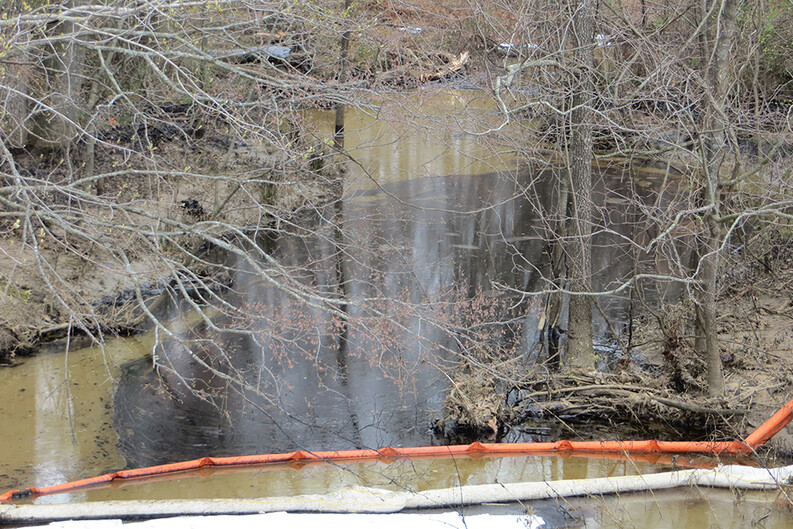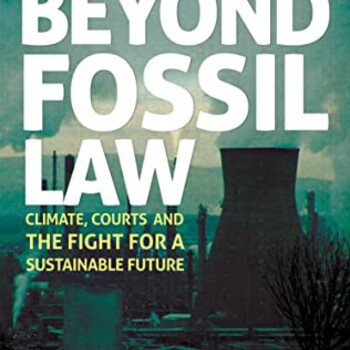An Excerpt from LEAP Student Fellow Ted Hamilton’s Book “Beyond Fossil Law”

Released on Earth Day 2022, Beyond Fossil Law: Climate, Courts, and the Fight for a Sustainable Future4 is a new book written by Ted Hamilton, a Ph.D. student in comparative literature at Yale, climate movement attorney, writer, and literary scholar. Hamilton is also the co-founder of Climate Defense Project5, which provides legal assistance to climate justice activists. Hamilton’s book chronicles the work of the Valve Turners, an American climate activist group that shuttered a tar sands oil pipeline in 2016. Hamilton places their work alongside grassroots climate activism projects around the world. His book explores why the activities of these groups are illegal while the continued production of harmful fossil fuels is permitted, and it takes on the “outmoded legal ideas” that enable the destruction of the climate.
Hamilton is also a fellow at the Law, Ethics, & Animal Program6 (LEAP) at Yale Law School, where he presented a talk7 on his book earlier this month. “Ted is a brilliant intellectual and a talented writer, with facility in numerous genres,” LEAP Faculty Co-Director Doug Kysar said. “He is essentially unparalleled within our community for the ability to range across disciplinary divides and encompass the full range of ideas and approaches that are necessary to understand and to appreciate the anthropocene. ”
Beyond Fossil Law is available now8. Read an excerpt from the book below.
Beyond Fossil Law by Ted Hamilton
Excerpt from Chapter 3: Guardians at the Sea Walls

What this book has been calling “fossil law” — the global network of rules and regulations that, paired with physical infrastructure, moves oil, gas, and coal from the earth to the air — was established to provide cheap and reliable energy. It has depended upon the consent and complicity of producers and consumers alike, and there is a great deal of responsibility to be passed around for the mess in which we find ourselves. Needless to say, the burden of blame grows greater as you move up the economic ladder, and, broadly speaking, Indigenous peoples, racial minorities, the working class, and the young will have less to account for in the final reckoning of the climate crisis than older and more affluent white people in the North Atlantic.
That’s one way to describe our addiction to fossil fuels. But qualification number one: the fossil fuel system wasn’t simply “established.” A market-focused story of how we came to rely on carbon-burning energy — the story that people naturally flock to a superior product—ignores the enormous influence that governments and corporations have played in promoting, even compelling, the use of fossil fuels. Our review of the legal infrastructure of extraction and consumption in the last chapter revealed that there’s no such thing as a natural market for oil, gas, and coal: it’s propped up by an elaborate system of subsidies, privileges, and favorable regulations.
Qualification number two: this story is not in the past. It’s ongoing. In fact, as the fossil fuel system confronts the twin challenges of climate change and popular resistance, its assertion of dominance has become ever more flagrant. We’re still living through an age of resource wars, only now much of the conflict is centered on enforcing the use of fossil fuels rather than on simply controlling their flow.
The use of coercive force, whether through state-sanctioned violence, criminal prosecution, or industry lawsuits, is an essential element in the legal system’s relation to the climate crisis. Too often, lawyers and academics consider environmental law to be simply a matter of government regulation, the topic of Chapter 1. But we cannot understand the dominance of the fossil fuel system—and we cannot hope to dismantle it—without also confronting the system’s fundamental reliance on legal violence. The Valve Turners’ court battles are just one example of how industry and state respond when their power is challenged.
The focus of this chapter is the criminal legal system, where the union between law, state power, and fossil fuels is most overt. The analysis begins by looking at how, in the United States, police forces started targeting radical environmentalists in the post-9/11 era, a campaign that laid the groundwork for the response to the first wave of mass climate mobilizations during the Keystone XL controversy. Two case studies then illustrate the state of criminal fossil law today.
First, the struggle against the Dakota Access Pipeline at Standing Rock shows how the repression of dissent and the violation of Indigenous rights are a necessary condition of the fossil fuel system’s ongoing operation. In the aftermath of Standing Rock, a wave of protest-suppressing legislation has spread across the country, strengthening the hand of the state as it supports the build-out of new fossil fuel infrastructure.
Next we turn to the Peruvian Amazon, where a study of resistance to oil drilling will illuminate the global alliance between fossil fuel corporations and sovereign states. Though this book focuses on climate law in the United States, there is an urgent need for instruction and inspiration from beyond our borders, where many of the best advances in the field are taking place. As such, a recent case emerging from a conflict in Bagua, Peru serves as a source of cautionary hope, suggesting a better path forward for courts as they deal with questions of Indigenous sovereignty, environmental well-being, and economic development.
Judicial opinions and statutes do not just exist on paper. For advocates eager for a healthier and more equitable world, one of the most pressing tasks is to transform the legal system from an agent of fossil fuel domination to one of climate justice liberation. Let’s see how that transformation might take place, starting with today’s dire situation and moving toward some models of a possible future.
The Other Environmental Law
Perform a simple thought experiment. Assume that the government heeded the warnings of climate scientists in the 1960s and that fossil fuels were deemed a danger to the public. Imagine armed officers arresting engineers at pipeline routes and mercenaries surveilling the movements of oil executives. Imagine counter-terrorism intelligence reports citing gas company stock prospectuses as evidence of threats to the social order. Picture neighbors of oil refineries calling 911 and seeing plant managers hauled off in cuffs.
This is not a state of affairs we should desire: the use of state violence is a crude instrument for climate justice, and one more likely to exacerbate conflicts than to resolve them. But the unlikeliness of the image emphasizes the absurdity of its obverse, which is our reality: sovereign power exercised in the interest of climate criminals.
We can identify several antecedents to this situation. As discussed in Chapter 2, the exertion of colonial and police power made it possible for the modern fossil fuel system to develop in the first place. Violations of the legal rights of Indigenous people, poor people, and communities of color — and the assault and prosecution of those who resist—have always gone hand-in-hand with the development of new energy reserves. As the fragile structure of environmental and administrative law begins to fracture — fossil fuel companies encountering greater legal resistance to their exploitation of permits and regulatory processes, climate justice advocates exposing the system’s inability to confront catastrophe—the once mundane business of infrastructure expansion has become a more naked assertion of force.


